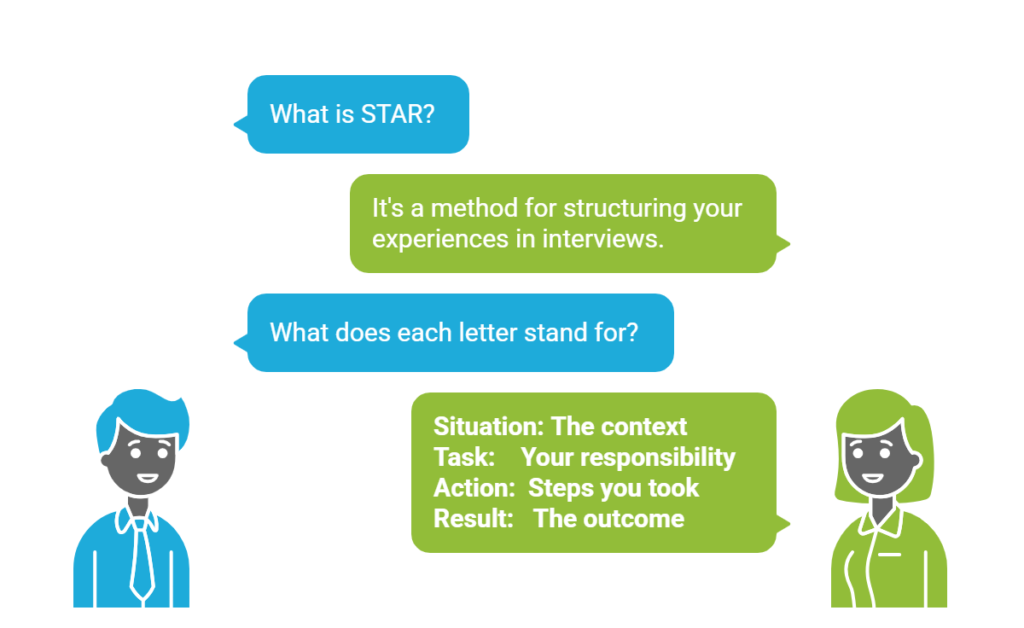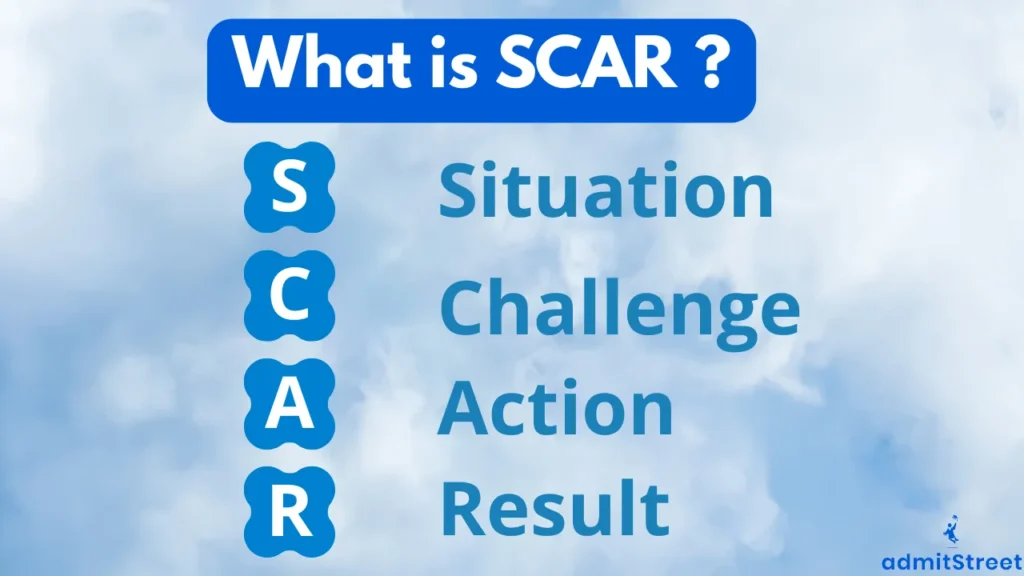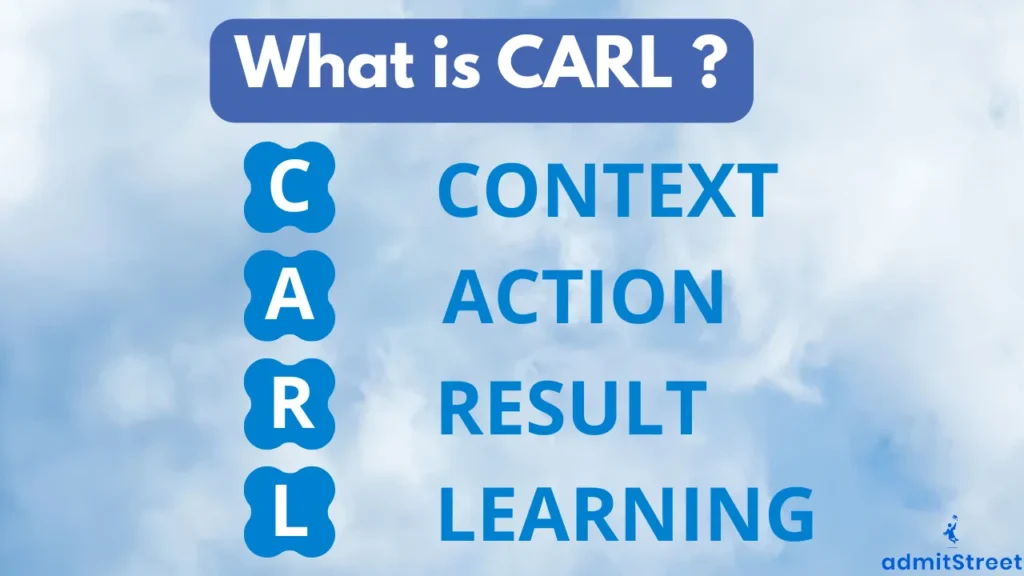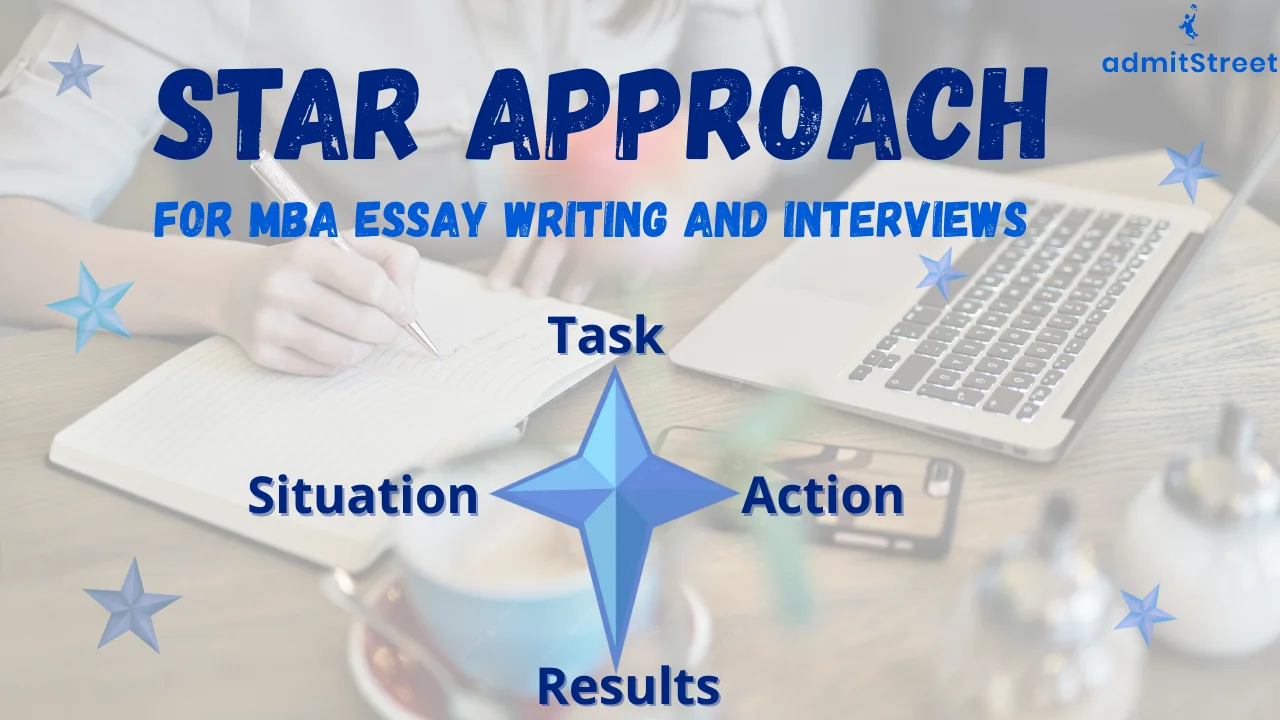The STAR approach is a powerful tool for crafting compelling essays and acing interviews, particularly in the context of MBA admissions. It provides a structured method for showcasing your experiences, achievements, and problem-solving abilities.
By clearly outlining the situation you faced, the task at hand, the actions you took, and the results you achieved, STAR helps you present your stories in a way that is both engaging and easy to follow.
This article will explore the STAR framework in detail, discuss its effectiveness, and provide insights into how to avoid common pitfalls. We’ll also delve into variations of STAR, such as SCAR and CARL, to help you tailor your stories to different types of essay prompts.
What is STAR?
The STAR method is a four-part storytelling framework that helps you structure your experiences into compelling narratives. Originally used in job interviews, it’s equally powerful for college admissions, scholarship applications, and interviews where you need to showcase your qualifications through real-life examples.

STAR is an acronym that represents:
- Situation: The context or background of the experience you’re describing.
- Task: The specific responsibility or challenge you faced in that situation.
- Action: The steps you took to address the task or overcome the challenge.
- Result: The outcome of your actions, including what you achieved and any measurable impact.
Components of STAR Framework
Situation
This is where you set the stage for your story. Describe the context, the environment, and any relevant details that give the reader a clear picture of what was happening. The situation should be specific enough to allow the reader to understand the challenges and constraints you were facing.
Example: “While working as a marketing manager at XYZ Corp, our team faced a significant drop in market share due to a new competitor entering the market.”
Task
The task is the specific challenge or responsibility you were assigned within the situation. It should clarify your role and what was expected of you.
Example: “My task was to develop a marketing strategy that would counter the competitor’s aggressive campaign and regain our market share.”
Action
Here, you describe the specific actions you took to address the task. Focus on your contributions, decisions, and steps you implemented. It’s essential to highlight your thought process, leadership, and problem-solving abilities.
Example: “I conducted a thorough market analysis to identify gaps in the competitor’s approach, reallocated our budget to focus on digital channels, and led a cross-functional team to launch a targeted social media campaign.”
Result
The result is the outcome of your actions. This is where you show the impact of your work, ideally with quantifiable results. It’s important to connect the results back to the initial situation and task, demonstrating how your actions led to success.
Example: “As a result, our campaign increased brand engagement by 40%, and we regained 15% of our lost market share within three months.”
From guidance to acceptance. See real results, then achieve yours.
Why the STAR Approach is Effective
The STAR approach is effective for several reasons:
- Clarity: It provides a clear structure that helps the reader follow your story without getting lost in details.
- Focus on Results: By emphasizing outcomes, STAR ensures that you highlight the impact of your actions, which is crucial in demonstrating your value to the admissions committee.
- Conciseness: STAR encourages you to be concise, focusing on the most critical aspects of your story without unnecessary digressions.
- Adaptability: The STAR approach can be adapted to a variety of essay types, making it a versatile tool in your essay-writing arsenal.
The STAR approach is particularly useful for essays that ask you to:
- Describe a leadership experience or a time you led a team.
- Discuss a challenge or failure and how you overcame it.
- Reflect on a significant achievement or accomplishment.
- Explain a situation where you had to make a difficult decision.
In these types of essays, the STAR framework allows you to present a compelling narrative that clearly demonstrates your skills, experiences, and the value you can bring to an MBA program.
Good vs. Bad STAR Essays: What Makes the Difference?
Understanding what distinguishes a good STAR essay from a bad one is crucial for crafting compelling responses in your MBA admissions essays. Below are examples of good and bad STAR essays, along with an analysis of what makes each effective or ineffective.
Good STAR Essay Example
Leadership Essay Example:
- Situation: “In my role as a project manager at XYZ Corp, our team was tasked with launching a new product within six months, but halfway through, we faced a significant delay due to supply chain issues.”
- Task: “I was responsible for finding a solution to keep the project on track and avoid a costly delay.”
- Action: “I negotiated with suppliers to expedite key components, reorganized the project timeline, and secured additional resources to ensure timely completion.”
- Result: “The product was launched on time, generating $2 million in revenue in the first quarter and receiving positive feedback from customers.”
Why It’s Good:
- Specificity: The essay provides detailed context, clearly outlining the situation and the challenges faced. The task is well-defined, making it clear what the applicant was responsible for.
- Focus on Action: The actions taken are described in a way that highlights the applicant’s leadership, problem-solving, and decision-making skills.
- Quantifiable Results: The results are measurable and directly linked to the applicant’s actions, demonstrating a tangible impact.
- Clear Structure: The STAR format is followed closely, ensuring that the story flows logically and is easy to follow.
Bad STAR Essay Example
Prompt: Describe a time when you had to unexpectedly use your leadership skills.
- Situation:
About a year ago, I was given the chance to lead a project when my manager fell ill. I wasn’t officially a “manager” at that time, so this was a significant opportunity that I took very seriously. - Task:
My primary responsibility was to quickly take charge and ensure that everyone on the team fulfilled their duties. It was crucial to meet the project deadline because the client we were working with was known for being difficult. - Action:
I first assessed the situation and decided to divide the work evenly among the team members. This was challenging because some team members were technically not as strong, and I knew I’d have to keep a close eye on them to ensure they met their deadlines. I then sought approval from my manager and the client. It took time to explain the situation to my manager, who wasn’t very technical, but he trusted my judgment and eventually agreed with my approach. Unfortunately, the client made additional requests, and I couldn’t convince them that these changes would delay the project. I returned to the office and adjusted everyone’s work assignments. Despite the client’s continued requests and changes, I managed to keep the project on track by working late nights and weekends to cover for some of the less motivated team members. After three months of intense effort, we met the deadline. - Result:
Thanks to my leadership skills, the project was completed successfully.
Issues with the Ineffective STAR Story
- Informal Language: Phrases like “given the chance” and “like” detract from the professional tone needed in an admissions essay.
- Focus on Title Over Actions: The candidate emphasizes the title of being a leader rather than detailing the specific actions taken to demonstrate leadership.
- Negative Tone: Criticizing team members as “technically not as strong” and describing the client as “difficult” may reflect poorly on the applicant’s interpersonal skills and professionalism.
- Lack of Quantifiable Results: The conclusion lacks measurable outcomes, missing an opportunity to showcase the significance of completing the project.
How to Improve the Ineffective STAR Story
To revise the ineffective STAR story into a compelling narrative, consider these improvements:
- Situation: “A year ago, I was unexpectedly entrusted with leading a critical project when my manager became ill. This was a significant responsibility, and I was determined to ensure the project’s success.”
- Task: “My main objective was to coordinate the team effectively to meet a tight deadline while upholding high-quality standards, particularly given that we were dealing with a demanding client.”
- Action: “I initiated a team meeting to evaluate everyone’s strengths and strategically distribute tasks, ensuring each member could contribute meaningfully. I maintained regular check-ins to provide support and resolve any issues. Moreover, I communicated proactively with the client to manage expectations and integrate their feedback without jeopardizing our timeline.”
- Result: “Through our collaborative efforts, we completed the project two weeks ahead of schedule, resulting in a 15% increase in client satisfaction and earning recognition from senior management for our teamwork and efficiency.”
This revision not only refines the language and tone but also emphasizes the applicant’s leadership skills, strategic thinking, and ability to achieve measurable results.
Common Mistakes When Telling STAR Stories in Admissions Essays and Interviews

The STAR method (Situation, Task, Action, Result) is a widely recognized framework for structuring compelling stories in admissions essays and interviews. However, many candidates make common mistakes that can undermine the effectiveness of their STAR narratives. Here are some of the most frequent pitfalls and how to avoid them:
Lack of Specificity
- Mistake: Using vague or general examples that lack concrete details and fail to showcase skills effectively.
- Improvement: Choose specific examples that are directly relevant to the question asked. Use clear, vivid details to illustrate the context, your actions, and the outcomes.
Neglecting the Result
- Mistake: Failing to articulate the results of your actions, which is a critical part of the STAR method.
- Improvement: Always conclude your story with a clear outcome. Quantify your results when possible, such as mentioning percentage increases in sales or improvements in efficiency. If quantifiable results are not available, focus on qualitative outcomes, such as enhanced team morale or client satisfaction.
Rambling and Lack of Focus
- Mistake: Losing focus and including unnecessary details that make the story unclear or unfocused.
- Improvement: Follow a clear structure and stick to the main points. Use transitions to guide the reader through your story. Practice your stories to ensure they are concise and within the appropriate length.
Exaggeration or Dishonesty
- Mistake: Embellishing or fabricating details in an attempt to make the story more impressive.
- Improvement: Be honest and realistic in your examples. Emphasize the positive aspects of your actions and results, but don’t be afraid to acknowledge challenges or mistakes you faced. Use confident and enthusiastic language without sounding arrogant or scripted.
Lack of Preparation
- Mistake: Failing to prepare a variety of STAR stories that showcase different skills and situations.
- Improvement: Before the interview or writing the essay, identify and practice 6-10 STAR stories that highlight key skills relevant to the program. This preparation will help you respond confidently and adapt your stories to specific questions.
Repeating Information from the CV
- Mistake: Retelling professional history that is already covered in the CV, wasting valuable space in the essay.
- Improvement: Use the essay to explain the motivations, passions, and values behind your career decisions. Demonstrate how the experiences shaped your personal growth and goals.
Variations of STAR: SCAR and CARL
While the STAR (Situation, Task, Action, Result) method is a popular framework for structuring responses in MBA admissions essays, there are other variations that can be equally effective depending on the type of essay prompt. Two such variations are SCAR (Situation, Challenge, Action, Result) and CARL (Context, Action, Result, Learning). These frameworks offer different approaches to highlighting your experiences, making them particularly useful for certain types of essays.
SCAR (Situation, Challenge, Action, Result)
SCAR is a variation of the STAR framework that emphasizes the challenges you faced in a particular situation. This approach is especially useful when you want to highlight your problem-solving abilities, resilience, and capacity to overcome obstacles. In SCAR, the “Challenge” component replaces the “Task” in STAR, focusing more on the difficulty or complexity of the situation.

Components of SCAR
- Situation: Describe the context or background of the scenario. Where were you? What was happening at the time? Set the stage for the challenge you were about to face.
- Challenge: Explain the specific challenges or difficulties you encountered. This is where you highlight the obstacles that made the situation particularly tough. Challenges could range from technical issues, resource constraints, or interpersonal conflicts to unexpected changes in project scope.
- Action: Detail the steps you took to address the challenge. This is where you showcase your decision-making, leadership, and problem-solving skills. Be specific about what you did and why you chose that course of action.
- Result: Conclude with the outcomes of your actions. What was the impact of your efforts? Did you achieve your goals, and if so, how? Quantify the results if possible, to demonstrate the effectiveness of your approach.
When to Use SCAR:
- Essays Focusing on Problem-Solving: If the essay prompt emphasizes overcoming adversity, solving complex problems, or navigating difficult situations, the SCAR approach can help you underscore the challenges you faced and how you tackled them.
- Essays Highlighting Resilience: For essays that ask about resilience or perseverance, SCAR allows you to emphasize the difficulties you overcame and how you grew from the experience.
Example of a SCAR Framework in Action:
- Situation: “As a senior analyst at XYZ Corporation, I was assigned to lead a crucial project with a tight deadline and limited resources.”
- Challenge: “Midway through the project, we encountered a significant challenge when our main supplier suddenly went out of business, threatening to derail our timeline.”
- Action: “I quickly identified alternative suppliers, renegotiated contracts, and reallocated resources to ensure the project stayed on track. I also kept open lines of communication with the client to manage expectations and provide regular updates on our progress.”
- Result: “Despite the setback, we successfully delivered the project on time, resulting in a 20% increase in client satisfaction and securing a follow-up contract worth $1 million.”
CARL (Context, Action, Result, Learning)
CARL is another variation of STAR that introduces a learning component, encouraging you to reflect on what you gained from the experience. This is particularly valuable in essays that ask about personal growth, development, or how past experiences have shaped your future goals. The “Learning” component in CARL replaces the “Task” in STAR, placing greater emphasis on the insights and lessons you gained from the experience.

Components of CARL:
- Context: Set the stage by providing the background or setting of the situation. This is similar to the “Situation” component in STAR, where you describe the environment and circumstances surrounding the event.
- Action: Describe the actions you took to address the situation. As in STAR, this is where you detail the specific steps you took, focusing on your role in the process.
- Result: Explain the outcomes of your actions. What did you achieve? How did your actions impact the situation? Be sure to include any measurable results to demonstrate the effectiveness of your approach.
- Learning: Reflect on what you learned from the experience. This is where you connect the experience to your personal or professional growth. What insights did you gain? How has this experience influenced your future behavior, decisions, or goals?
When to Use CARL:
- Essays on Personal Growth: If the essay prompt asks you to reflect on a time when you learned something significant or experienced personal growth, CARL is an ideal framework. It allows you to not only showcase your actions and results but also to demonstrate self-awareness and the ability to learn from experiences.
- Essays About Leadership Development: For essays that focus on leadership development, CARL enables you to highlight how specific experiences have shaped your leadership style or approach.
Example of a CARL Framework in Action:
- Context: “During my time as a marketing manager at ABC Company, I was tasked with launching a new product in a highly competitive market.”
- Action: “I developed a comprehensive marketing strategy that included targeted digital campaigns, influencer partnerships, and a launch event. I also collaborated closely with the sales team to ensure alignment between our marketing and sales efforts.”
- Result: “The product launch was a success, achieving a 30% market share within the first six months and exceeding our sales targets by 15%.”
- Learning: “This experience taught me the importance of cross-functional collaboration and the value of integrating different perspectives into a cohesive strategy. It also reinforced my belief in the power of data-driven decision-making, which I have since applied to other successful campaigns.”
FAQs : STAR Approach
Q1: What is the STAR method for college admissions?
A: The STAR method (Situation, Task, Action, Result) is a structured storytelling framework specifically adapted for college admissions. It helps applicants transform personal experiences into compelling narratives for essays and interviews by providing a clear format that highlights skills, character, and growth—exactly what admissions committees look for.
Q2: How is the STAR method used in college essays?
A: In college essays, the STAR method structures your personal story: the Situation sets the scene, the Task presents your challenge or goal, the Action details your specific steps and decisions, and the Result shows the outcome and, crucially, your personal growth or learning. Unlike interviews, these elements are woven seamlessly into a narrative rather than stated explicitly.
Q3: What are good STAR method examples for scholarship interviews?
A: Strong STAR examples for scholarship interviews demonstrate leadership, resilience, and impact. For example: Situation: Leading a project with a tight deadline. Task: Motivating an unengaged team. Action: Implementing weekly check-ins and peer recognition. Result: Project completed early, team morale improved, and learning that effective leadership involves empathy and structure.
Q4: What is the biggest mistake students make with the STAR method?
A: The most common mistake is spending too much time describing the Situation (50%+ of the answer) and not enough on the Action and Result. Admissions officers care most about what you did and what you learned. Aim for 20% Situation/Task, 50% Action, and 30% Result/Learning.
Q5: How long should a STAR answer be in an interview?
A: A strong STAR answer in an admissions interview should be 90-120 seconds long. Structure it as: 20-30 seconds for Situation/Task, 45-60 seconds for Action (the most important part), and 20-30 seconds for Result and Reflection. Practice conciseness to maintain impact.
Q6: What’s the difference between STAR and SOAR or CAR methods?
A: While STAR (Situation, Task, Action, Result) is ideal for behavioral questions, SOAR (Situation, Obstacle, Action, Result) emphasizes overcoming challenges, and CAR (Challenge, Action, Result) is more concise. For admissions, STAR is most recommended because the “Task” component helps clarify your specific role and responsibility, which is crucial for personal narratives
Q7: Can the STAR method work for “Why This College?” essays?
A: Indirectly. You can use a past STAR story to demonstrate qualities that align with the college’s opportunities. Structure it as: “My past experience in [Situation/Task] where I [Action] with [Result] demonstrates my readiness to contribute to [Specific College Program/Community].” This connects proven capability to future potential.
More MBA Guides & Insights
- 10 MBA Interview Tips from an Admissions Interviewer
- 10 MBA Essay Tips and Step-Wise Essay Writing Guide [2025]
- How to Finance Your MBA : A Comprehensive Guide for 2025
- MBA after 30 – Is It Worth the Investment?
- Round 1 vs. Round 2 vs. Round 3 Apply in this MBA application round
- MBA Abroad: A Complete Guide
- Who are M7 Business Schools: An In Depth Guide on M7 MBA in 2025
- Top MBA Programs in Europe 2025
- Top MBA Programs in the World (2025)
- MBA Resume: Format, Examples & 10 Tips to Impress the Admissions Committee
Final Thoughts
Mastering the STAR approach is crucial for anyone looking to make a strong impression in MBA admissions essays and interviews.
By structuring your experiences in a clear and compelling manner, STAR allows you to highlight your leadership, problem-solving, and teamwork skills effectively.
Understanding the nuances of what makes a good STAR story versus a bad one, as well as being aware of common mistakes, can significantly enhance the quality of your application.
Additionally, exploring variations like SCAR and CARL can provide further flexibility in how you present your experiences, ensuring that you can adapt to any essay prompt or interview question with confidence.
Still Perfecting Your
STAR Method for Admissions?
The gap between what you’ve done and how you tell it determines your success. Let us help you bridge it with a structured framework for standout essays and interviews.


